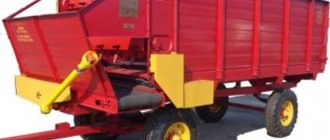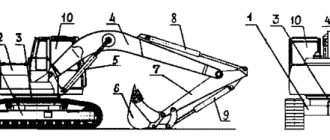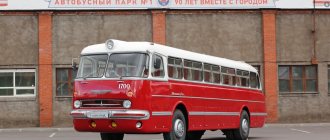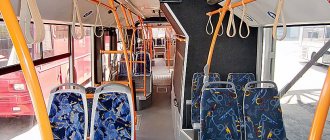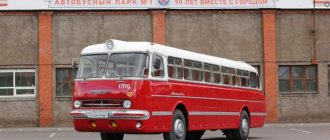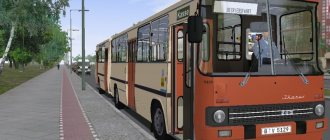Excursion to PAZ - Pavlovsk Bus Plant (PHOTO)
The plant in Pavlovo was founded in 1932. It was initially designed to produce driver's tools, as well as body fittings for cars from the Gorky and Ulyanovsk automobile plants.
The first bus based on the GAZ-51 car was released in August 1952. Next year will be a jubilee year for the factory workers. During its existence, more than 600 thousand vehicles of various models and modifications were produced under the PAZ brand.
Our tour of the plant began with the welding shop, where the birth of the bus body takes place.
This is where the factory conveyor begins.
The frame is welded on the slipway. The outlines of the future bus can already be guessed.
PAZ introduced the best technologies, successfully tested and used in the West. Gone are the huge warehouse spaces. The production of components goes two steps ahead of installation, the so-called “assembly from wheels”.
To be honest, I was amazed by the production culture at this enterprise. And these are not empty words; once I was able to visit one of the best defense plants in the country - PAZ is at its best.
There may be objections and examples of sterile workshops in Western factories, but let's not forget where we are and where the West is. Especially for critics - to feel like you are in the shoes of a manufacturer operating in Russia, first open at least an individual entrepreneur. And if in a couple of years you're still paying taxes, then we'll have something to talk about.
PAZ is a city-forming enterprise; there are no Chinese or Tajiks here. We must pay tribute to the management of the enterprise; buses continue to be produced under the factory brand. All buses produced at PAZ since 1952 are produced only under the PAZ brand, with the lily logo.
About five thousand employees work at the plant and receive stable wages.
The frame of the future bus begins its journey on the assembly line.
The most popular PAZ 3205 bus, even the Chinese auto industry could not break it.
Welders in Pavlov are just as tough as their colleagues from Chelyabinsk.
All “stamping” is done in a neighboring workshop.
According to the head of the welding shop, a welder is the highest paid working specialty at the plant.
A plate with the VIN number on the groove.
The finished housings are sent to the painting shop. Let's follow them.
Primed body ready for painting.
In 2009, a new generation painting complex “Aizenman” was put into operation.
Before the introduction of new equipment, the paint shop was a big headache for all workers and management of the paint shop.
The suspension of primer and paint hung like a curse over all the workers in the workshop, but now it is a thing of the past.
It seemed to me that the paint shop was staffed entirely by women.
The freshly painted bus is ready to go to the assembly line.
The cute creature commands the dispatch.
The next stage of our tour is the assembly shop. Let's go there.
At any Russian plant that is not burdened with traffic police registration and GOSTs, you can find amazing vehicles. Local Lefties beat their swords into ploughshares.
And the base of the GAZelle was reduced to an indecent one and a half meters.
Various modifications of PAZ brand buses are assembled on the assembly line.
PAZ-3204 was put into serial production in January 2009. Recognized as the Best Bus of the Year in 2009, 2010, 2011.
Please note, the passenger seats are a new model. And let’s compare them with the old “sedushki”, their photos will be below.
Installation of the battery pack.
At the moment, three engine models are being installed on the PAZ conveyor. Diesel MMZ, gasoline ZMZ, diesel Cummins. From 2012, PAZ 3204 buses will be equipped with a YaMZ 530 diesel engine.
The photo shows a Cummins engine.
Bridge sub-assembly area.
Footers, photo for those in the know.
Seats from the last century. By the way, an irreplaceable thing when working under a car.
Yellow color, school bus modifications. Among other changes, it has seats equipped with seat belts and racks for school backpacks. Each seat is equipped with a button to communicate with the driver, and an additional step, which, when open, stops the movement of the bus.
Good old "Pazik". The small class bus is still the main model of the plant.
Factory time, the countdown of finished products is underway. Every day, 36 brand new buses leave the assembly line.
Engine installation area for buses.
The area where the chassis and engine meet.
Computer diagnostics and engine tuning.
Gluing windows.
PAZ-3204 is a new model of the plant, designed to replace the veteran PAZ-3205 on the assembly line.
Brake system test bench.
A brand new bus leaves the assembly shop.
At the end of our excursion, we were shown the new, flagship model of the plant workers PAZ-320412, a bus with the symbolic name Vector.
Meeting him left me with only pleasant impressions. Build quality and performance are at the highest level. It became known that there are already customers for the purchase of large quantities of this bus model.
I left the factory in full confidence that PAZ has a future!
kramtp.info
Additional options
- Insulated package
- Insulated package (only for Spanish podium)
- Comfort type passenger seats, non-adjustable, with seat belts
- Separate passenger seats, Standard type, without seat belts
- Comfort-type passenger seats, adjustable with seat belts (only for use in Podium)
- Seat belts on passenger seats Standard
- Fog lights with DRL (without DRL for buses with ZMZ carburetor engine)
- Reverse buzzer
- Electrically heated exterior mirrors
- Comfortable driver's seat with air suspension
- Autonomous air heater (power 4 kW) only for use. podium
- Additional ventilation hatch
- Tinted glazing
- Luggage racks
- Curtains
- Digital tachograph with CIPF unit
- GLONASS/GPS satellite navigation equipment
- Audio system - installation of a car radio, antenna and 4 speakers throughout the cabin
Door to the cargo compartment. Photo GAZ
- Electrically heated exterior mirrors
- Broadcast Loudspeaking Device (internal)
- Broadcast Loudspeaking Device (external)
- User terminal
- CD/MP3 player + 4 speakers + installation
- DVD radio + installation
- DVD system Monitor 15” + installation
- DVD system Monitor 17” + installation
- DVD system Monitor 19” + installation
- Microphone + control unit
- Anti-corrosion treatment
- Rear view camera with color monitor
- Parking sensors 4 pcs. (2 front, 2 rear or 4 rear)
- Parking sensors 8 pcs. (4 front, 4 rear)
- Alarm and two 2-button programmers. keychain
- Starline alarm and key fob with two-way communication and LCD display + installation
- Central locking kit+installation
- Breathalyzer lock (engine blocking with a positive breathalyzer reading)
- Winter/summer tire set
- Discs
- Motorist set
- Set of consumables for TO 1, TO 2, TO 3
- Set of engine belts and brake linings
technical specifications and photos :: SYL.ru
Small class buses are an excellent solution for transporting passengers across regions, cities or intercity. The main advantages of such bus equipment are mobility, high cross-country ability, and maneuverability. This technique shows good results both in the city with active traffic and when driving on the highway.
Main small bus
In our country, the Pavlovsk Bus Plant is engaged in the production of such vehicles. This manufacturer has been noted more than once as one of the largest. The line of bus models that are produced here represents a wide range of various equipment. And the PAZ-672 model is the main representative of the small class, which was mass-produced from 1967 to 1989. Over 22 years, about 288 thousand copies were produced. This is a simple and neat machine, which was unpretentious in service, and the costs of its operation were minimal. The bus had low fuel consumption, and the price of the car was very reasonable.
History of creation
There are no particularly outstanding moments in its history. The first sample (PAZ bus model 672) was shown in 1960. But before this model began to be assembled on the assembly line, a whole 8 years passed. Over the years, the company's engineers and designers managed to build several prototypes. They were all very different from each other. But they have nothing to do with our bus.
PAZ's birthday can be considered November 12, 1968. It was on this day that the plant began producing model 672 without stopping the conveyor. For 20 years, the car visited all corners of the Soviet Union, was delivered to Europe, Asia, Africa, as well as to some Latin American countries.
Creation and improvement
As already mentioned, the PAZ-672 bus was not immediately put into production. Before putting it on the conveyor, the designers went through a large number of various improvements and modifications.
The project to create a small class bus began back in 1957. The car was equipped with an 8-cylinder engine, chassis from a GAZ-53 and a steering system equipped with a hydraulic booster.
During testing and operation over the course of a year, it was possible to identify and completely correct many design and engineering defects. After this, the PAZ-672 bus was created, which received a new body copied from the 652 model. The brake system had separate transmission to the axles.
After certain departments conducted research, the design of the machine was radically changed. The frame on which the body is built was completely modernized, the weight was reduced, and the windows were made wider. During this period, they managed to assemble about 20 such machines.
Regular changes
The design of the bus was constantly modernized and changed in every possible way. So, in 1969 the engine was subject to modernization. Engineers managed to increase its service life and strengthened the reliability of the hydraulic steering system and brakes. Work was carried out to seal the body. The steering wheel now had a gear shift knob. Then, in 1975, the service life of the bus was increased. It was 320,000 km before the first major overhaul. In 1980 it was already 350,000 km.
Design work
The lighting equipment of the PAZ-672 bus was also improved, but the work was carried out from a design point of view. Here the small round turn signals were replaced with larger ones. They were square in shape and also more convex.
The taillights, previously round, became square. These were sections left and right. Each of them included 4 headlights. As a result of such design modifications, all lighting equipment is installed as a single unit.
PAZ bus - photo of the 672nd model and design features
The bus had a standard carriage layout. The cabin could accommodate up to 23 passengers on seats, and the total capacity was 45 people. Practice has shown that about 100 people can fit here with some comfort. The window sizes, which were not too large, compensated for the additional windows at the base of the roof.
The doors were quite narrow. They opened and closed using a pneumatic drive. Only one person could go through them. The driver's cabin had a separate door, and the cabin was separated from the cabin by a small light partition, but more often a curtain served as a barrier. There were 6 flaps in the body for natural ventilation.
PAZ-672 - technical characteristics
Over the course of 22 years, many modifications of this model were released. Over the years, the bus was equipped with different engines and also had different characteristics. According to some reports, the engine of the 52nd GAZon was used as the power unit. According to other sources, it is known that more modern models work on ZMZ-672.
The basic model, in terms of its technical characteristics, adopted a lot from the GAZ-52A. On the PAZ-672 bus, the engine is a 115-horsepower four-stroke eight-cylinder overhead valve carburetor unit. The engine volume was as much as 4.25 liters. The car was also equipped with a 4-speed gearbox and a front axle.
The carburetor is located in the front overhang. This may explain that the front door is slightly offset. The clutch system is presented in the form of a single-plate dry clutch with a hydraulic drive. The spring suspension included telescopic liquid shock absorbers from the ZIL-157 car. They worked very reliably and provided excellent wheel grip on the road. The brakes are made in the form of a separate drum drive. This system was equipped with hydraulics, as well as a vacuum booster.
The length of the body was 7,150 mm, the width was 2,440, and the height of the bus was 2,952 mm. The wheelbase had a size of 3,600 m. The ground clearance was 280 mm. The weight of the fully loaded vehicle was 4.5 tons. The total weight reached 7.8 tons. The peak speed that could be achieved on this bus was 80 km/h. Fuel consumption was 20.5 liters.
Modifications
Over 22 years, many modifications have been released. For example, at the end of 1982 they began to produce the modernized model 672M. The classic version of the PAZ bus (model 672) was significantly inferior to this modification. The new model had greater engine power and the design of the passenger seats was safer. The model was distinguished by thermal and noise insulation in the cabin. A little later, single-door buses 672 were called 672M. Their production ceased in 1989, but today you can still find this car on the roads. Such buses were used at enterprises as service buses.
Next was model 672A. This is a tour bus. Its special feature is its retractable roof. The car was distinguished by a door that was opened manually. The release was canceled because marketing research showed it was unprofitable.
Model PAZ 672Yu - chassis that was exported. In Cuba, many interesting vehicles were built on the basis of this chassis.
672G was used mainly in the mountains, at least the designers made it that way. Therefore, the model was equipped with two fuel tanks. Belts were provided for passengers, and the bus had a reinforced braking system.
Also based on this model, the so-called PAZ “Penguin” 672 was built. Why “Penguin”? Because it's a refrigerator. The car was brand 3742 and came with a refrigerator. There was a snowflake painted on the sides of this bus. Penguins were very popular in the Soviet Union.
672TL was used as a research laboratory. The modification featured a solid roof, as well as internal partitions.
652C was developed for the northern parts of the USSR. This model featured enhanced independent heating, double glazing, and a roof without glass. The car had improved seals on the doors, hatches and windows.
Diesel option
The plant also tried to produce a diesel model. It was called 672D. It was a one-off car. The engine here was a Minsk diesel engine. However, the bus did not go into production.
A lot of interesting things were built on this basis, but this is the topic of a separate article. These buses were used to transport food, go on tourist trips, and even before the mid-1990s they could be seen on routes in small towns. Why not? Low fuel consumption, maneuverability, speed, and good suspension enabled the bus to become so popular.
Today these cars are no longer there, but you can feel nostalgic about this topic and look through the photographs.
So, we looked at the design and technical characteristics of the Pavlovsk bus. As you can see, this model has many interesting moments in its history. But, like any other bus, sooner or later it had to undergo changes. Now the plant produces modern tourist and city buses, which are more reliable, convenient and comfortable.
www.syl.ru
Chassis characteristics
Utility bus PAZ-32053-20. Photo Mega-Service-NN
Brand. KAAZ.
Main bridge. Rear.
Wheel formula. 4x2.
Wheelbase, mm. 3600.
Ground clearance/ground clearance, mm. 258.
Clutch type. Single-disc, dry, with torsional vibration damper and hydraulic drive.
Tires (size). 8.25 R20.
Anti-lock braking system (ABS). Eat.
History of the Soviet bus PAZ Tourist Lux 8.5 m
In November 1968, the main set of working drawings was transferred to the experimental workshop.
The bus was assembled on March 29, 1969, with body number ETs-106. PAZ-Tourist Lux had a length of 8.5 meters, a width of 2.5 meters and a body height of 2.78 meters. The well-proven ZIL-130 engine with a power of 150 hp was used as the power unit. We used a five-speed gearbox from ZIL-130. For the first time on a PAZ brand bus, this model used a rear engine. The reduced height in proportion to the length of 8.5 meters visually gave the bus a sense of speed. PAZ-Tourist Luxury was painted dazzling white. The seats in the passenger compartment were bright cherry. Among themselves, the factory workers nicknamed their car “Aurora.” The PAZ-Tourist Lux consisted of three compartments, separated by partitions. In the first compartment there was a passenger compartment and a platform occupied by the driver and guide. The comfortable bus was designed for 24 passenger seats, which were equipped with individual electric lighting, each passenger seat was adjustable. The chairs were anatomical with headrests, imported. Forced ceiling ventilation distributed air flow to each seat. The driver's and guide's seats were lowered by 20 cm, relative to the level of the passenger seats, so as not to limit the traveler's view forward. Large curved side and front panoramic windows were used for good visibility. These glasses were produced at the Saratov Technical Glass Plant. The guide's chair was swivel. To provide excursions, the guide had a microphone and tape recorder at his disposal. In the passenger compartment, under the roof, luggage racks were installed, trimmed with artificial leather on a foam rubber base. For the convenience of passengers, the central part of the floor was lowered, which made it possible to create a main passage with a height of 1.85 meters, with a total body height of 2.78 meters. fishki.net
Engine/powertrain characteristics
| Options | ZMZ-52342.10 | YaMZ-534 | MMZ D-245.9 |
| Type | Gas engine | Diesel engine | Diesel engine |
| Number and arrangement of cylinders | 8, V-shaped at an angle of 90° | 4R | 4R |
| Environmental safety standards | Euro 4 | Euro 5 | Euro 5 |
| Working volume, l. | 4,67 | 4,43 | 4,75 |
| Engine power, kW (hp)/min. | 90 (122.4) at 3200 min-1 | 99 (134.6)/ 109.5 (148.9) at 2300 min-1 | 95.5 (129.8) at 2400 min-1 |
| Max. torque, Nm/min. | 288 at 1600…2000 min-1 | 422 at 1200…2100 min-1 / 583 at 1300…1600 min-1 | 455 at 1200…1600 min-1 |
| Engine location | Anterior longitudinal | Anterior longitudinal | Anterior longitudinal |
| checkpoint | Manual transmission: GAZ-3307, 4 or 5 speed. | Manual transmission: S5-42, 5-speed. | Manual transmission: SAAZ 3206, 320670 5-speed. |
| Maximum speed, km/h. | 90 | 95 | 95 |
| Bus warranty | 2 years or 60 thousand km | 1.5 years or 75 thousand km | 1.5 years or 50 thousand km |
Front-rear axle suspension. Spring-spring.
Control fuel consumption at 60 km/h, l/100 km. 20,5.
History of PAZik. — 1922 — 1991: USSR in photos
Pavlovsk Bus Plant LLC began its history as a plant for the production of automotive and tractor tools (ZATI) for the Gorky Automobile Plant.
Construction of the enterprise began on August 5, 1930. Mass production of products bearing the ZATI brand began in October 1932. 1952 is the date of the “rebirth” of the plant. On April 24, 1952, a plan for the reconstruction of the plant and a program for the production of 10 thousand buses were approved. On August 5, 1952, the first five buses with the PAZ brand left the factory gates.
The production of buses was increasing, the company was preparing to produce a new model of the carriage-type bus PAZ-652, the design of which was developed in-house. In 1960, serial production of these machines began.
In 1967, at a competition salon in France, the PAZ-655T bus was awarded the Grand Silver Medal of the French Commissariat for Tourism, a prize of distinction and a motor show medal.
In 1969, at the international bus show-competition in the French city of Nice, for the most difficult tourist rally route, the PAZ-Tourist Luxury bus was awarded an honorary prize of the XIX International Competition - the Grand Cup and the Golden Nika prize.
On November 12, 1968, a new model, the PAZ-672, was delivered to the main conveyor of the plant.
Buses of the northern version PAZ-72S and PAZ-3202S were produced in a single technological flow,
all-terrain buses PAZ-3201,
buses for tropical climates PAZ-672Yu,
buses for mountainous areas PAZ-672G.
In 1989, the plant switched to mass production of PAZ-3205 buses.
July 30, 1998 The 500,000th PAZ bus rolled off the assembly line of the plant. On the same day, the start of production of large city buses was announced.
In August 1999, Pavlovsky Bus OJSC was awarded a special prize at the Moscow International Motor Show 99 for the development of the PAZ-3209 Aurora buses.
and city buses PAZ-5271 and PAZ-5272.
In 2000, new facilities were put into operation for the production of city and intercity buses of large and medium class PAZ - 5272 and PAZ - 4230 Aurora.
In 2001, serial production of the PAZ-4230 bus was launched. Today, the production of Aurora buses continues at KAVZ LLC.
In 2002, the production of middle-class buses PAZ-4234, unified with the base model PAZ-32054, was mastered.
In August 2007, the plant celebrated two anniversaries at once - the 75th anniversary of the creation of the enterprise and the 55th anniversary of bus production. In the anniversary year of 2007, the 600,000th bus with the industrial brand "PAZ" rolled off the main assembly line of the plant - the darling of Russian roads.
The text was taken from the website. Photos from Yandex.
cccp-foto.livejournal.com
price, photo, characteristics, video PAZ
Test assembly of the new PAZ-2256 Vector-3 compact buses, intended for urban and suburban transportation, has begun at PAZ production facilities.
The model is built on a meringue chassis by Isuzu. Vector-3 is capable of carrying up to 33 passengers, including 20 seats. The overall length of the bus is 7360 mm, height is 2800 mm, and width is only 1960 m.
photo PAZ-2256 “Vector-3” 2015
Detailed description, device
PAZ-32053-20 is used for transporting shift workers, specialized construction teams, and seasonal workers in agriculture.
It is undergoing a phased modernization to improve reliability, service life and consumer characteristics.
Utility bus PAZ-32053-20. Photo YarCamp
Cargo compartment volume – 10 cubic meters. When equipped with a gasoline engine, the simultaneous transportation of 11 people and 1850 kg of cargo is possible, when equipped with a diesel engine - 10 people and 1780 kg of cargo.
A bus with a diesel engine is equipped with an engine brake as standard.
